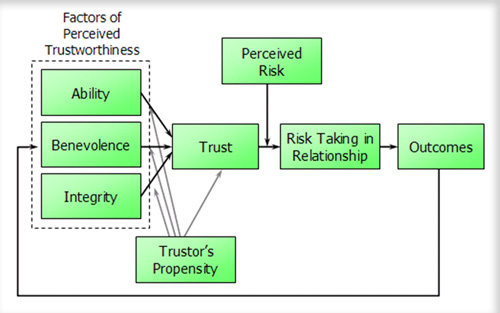The proposed model of trust put forward by Mayer and his colleagues has come in very handy during my own Enterprise 2.0 implementation projects and I hope it gives you greater insight if you haven’t come across it before.
5. The central ingredients (part 2)
Trust
Explicit Knowledge Stores (in the form of electronic databases) just don't work on their own. War stories abound:
… "Yet these investments have rarely had the intended impact. While databases (and staff to support them) have grown to mammoth proportions, they are often underutilised as employees are much more likely to turn to peers and colleagues than to impersonal sources for necessary knowledge. The result has been a "second wave" of knowledge management advice geared toward promoting effective collaboration and learning in strategically important groups." (Abrams et al., 2003, p.64)Tuomi (2002) also talks about the next stage of Knowledge Management:
Towards the end of the 1990’s, social learning, organizational sense-making, and systemic innovation and change management became prominent themes in knowledge management. In the next years, knowledge management theorists and practitioners will find themselves asking how revolutions can be managed.One key ingredient in this venture is trust, one definition of which is “a psychological state comprising the intention to accept vulnerability based upon positive expectations of the intentions or behaviour of another.” One thing almost all researchers agree on is the concept of vulnerability. The presence of trust provides conditions where cooperation and more positive attitudes lead to higher performance. This happens both directly and indirectly due to a willingness to enter into relationships that involve vulnerability. (Dirks and Ferrin, 2001, p.451,455)
There is some debate about which characteristics build or affect trust, however Mayer (et al, 1995, p.715) proposes a model of trust (Figure 2) which combines the trustor’s propensity to trust with three antecedents – integrity, ability and benevolence - that are required before trust can exist between two parties.
It is important to note that trust itself is based on perceptions. While the trustee can build trust, they do not do so directly, but may build trustworthiness by aligning their actions with these antecedents.
Behavioural Integrity
Behavioural Integrity (BI) can be defined as the perceived pattern of alignment between an actor’s words and deeds (Simons, 2002, p.19). It includes the perception of espoused values matching enacted ones. It can be damaged by the breaking of promises and psychological contracts and in the case of leaders, any actions contradictory to corporate mission and value statements. As a pattern of alignment, it is built up over time through reiterative observations, however the focus on word-deed alignment precludes any consideration of moral principles.
While all individuals develop a perception of trustworthiness over time, Leaders tend to be given less latitude in their deviations. Simons suggests a trustor’s perception of misalignments goes up with the importance of the focal issue. Leaders have control over many such issues within an organisation and are thus their actions are constantly “in the limelight” so to speak.
At another level, organisations themselves can be ascribed a level of BI by those who deal with them at arms length. In this case the pattern affects their credibility in the marketplace. Simons asserts that “BI is highly problematic in today’s managerial environment of rapid competitive, technological and organizational change…” and that “it has profound consequences for employee retention and performance…” (Simons, 2002, p32).
Simon’s model indicates that relatively small word-deed misalignments can have significant consequences, so understanding the organisational culture can aid managers in maintaining BI, especially in times of organisational change.
Figure 2: Proposed model of Trust – (Mayer, et al, 1995)
Ability
The possession of skills or expertise to carry out a task will not only affect other’s perception of trust, will also tend to limit in which domains an individual can be trusted (Mayer et al., 1995p. 717).
Benevolence
“Benevolence is the extent to which a trustee is believed to want to do good to the trustor, aside from an egocentric profit motive.” (Mayer et al., 1995, p.718). It is often linked in the literature with prior relationships and some have considered it synonymous with altruism.
It plays a large part in initial trusting relationships as there is insufficient past experience for BI to be considered, however ongoing relationships will change based on the outcomes of previous trust experiences. This is shown in Figure 2 by the feedback loop from outcomes back to the antecedents.
Situational Strength
The question of how trust affects organisational performance is considered by Dirks and Ferrin (2001, p.461-2) who argue that alongside the traditional Main Effect model where trust has a direct affect on organisational processes, a second model of Trust as a Moderator. They borrow the model of ‘situational strength’ from Mischel to provide conditions under which each model will apply to a scenario.
According to Mischel (1977, p.347), “strong” situations are those in which guidelines and incentives motivate most actors to 1) construe the situation in the same way, 2) draw similar conclusions as to appropriate responses, and 3) behave in a particular way. Depending on this strength, trust may be reduced to a moderating role, modifying interpretations and actions, or cultural norms may provide unambiguous cues, making interpretation not required and removing trust’s influence entirely.
Alternatively, “weak” situations are those that lack these traits and allow for individualised interpretation and action. In these scenarios, trust as a Main Effect holds considerable power in reducing uncertainty and supporting action (Mayer et al., 1995, p.730, Dirks and Ferrin, 2001, p.461).
Discovering an organisation’s assumed norms and values allows members to determine when trust will be a determinant factor. Furthermore, a management focus on issues of behavioural integrity will not just improve trust, but have a flow-through effect by modeling cultural standards that will lead to a greater propensity to share knowledge through the group.







0 Comments